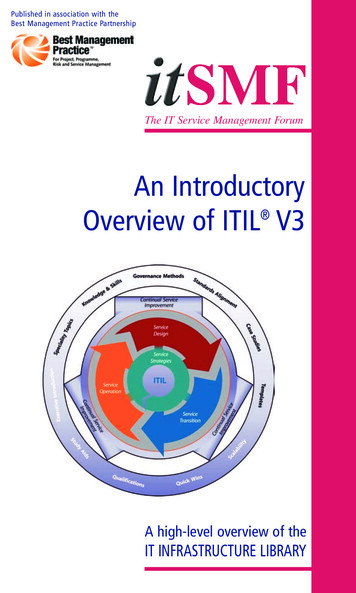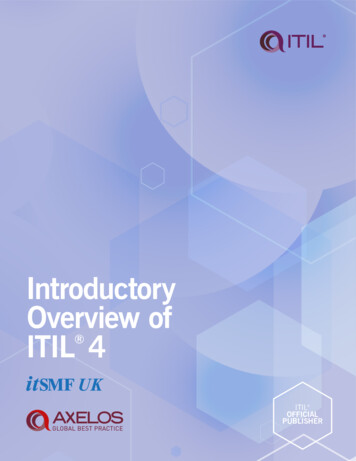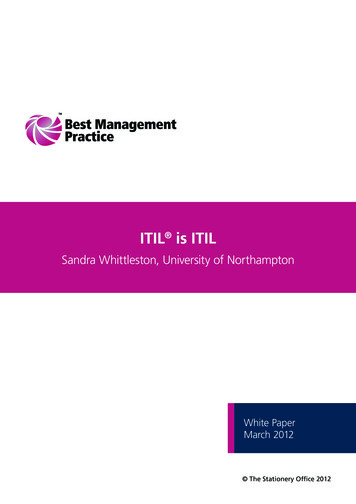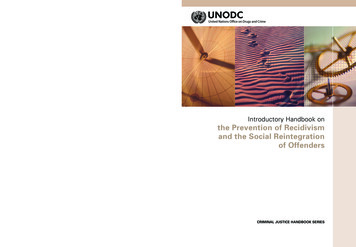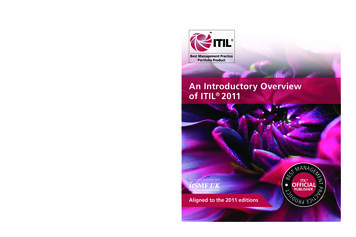
Transcription
Best Management PracticePortfolio ProductTUCANAGETM8255 ITIL Overview Intro Cover V0 4.indd All PagesE PRODTICAligned to the 2011 editionsPrint run sponsored by AXELOSNT PRACMEPublished in association withBESAn Introductory Overview of ITIL 2011An Introductory Overviewof ITIL 201128/10/2013 15:43
BECOME AMEMBER TODAY 481 AXELOS Kegs Ads v0 9.indd 1Join itSMF UK and enjoy: free regional events and specialinterest groups; industry-leading seminars with aworld‑class range of guest speakers; professional development andcredentialing through priSM; ITSM publications, white papers andcase studies; an online bookshop offeringsubstantial discounts andspecial offers; ITSM maturity assessments; a full-colour quarterly magazine,ServiceTalk; networking opportunities and industrythought leadership; a celebrated annual conferenceand exhibition.For more information uk21/10/2013 09:48
Best Management PracticePortfolio ProductAn Introductory Overviewof ITIL 2011 379 An Introductory Overview of ITIL 2011 v0 5.indd 1London: TSO03/10/2013 10:03
Copyright itSMF Ltd, TSO 2012This version first published 2012Based on other copyright material with thepermission of the copyright owners.Published by TSO (The Stationery Office)and available from:Onlinewww.tsoshop.co.ukMail, Telephone, Fax & E-mailTSOPO Box 29, Norwich, NR3 1GNTelephone orders/General enquiries:0870 600 5522Fax orders: 0870 600 5533E-mail: customer.services@tso.co.ukTextphone 0870 240 3701TSO@Blackwell and other Accredited Agents379 An Introductory Overview of ITIL 2011 v0 4.indd 2ITIL is a registered trade mark ofAXELOS Limited.PRINCE is a registered trade mark ofAXELOS Limited.MoP is a registered trade mark ofAXELOS Limited.MoV is a registered trade mark ofAXELOS Limited.MSP is a registered trade mark ofAXELOS Limited.P3O is a registered trade mark ofAXELOS Limited.COBIT is a Registered Trade Mark of ISACAand the ITGA.CMM is registered in the USA Patent andTrademark Office.PMBoK is a Registered Trade Mark of theProject Management Institute.M o R is a registered trade mark ofAXELOS Limited.The Swirl logo is a trade mark ofAXELOS Limited.The Best Management Practice Portfolio Productlogo is a trade mark of AXELOS Limited.The Best Management Practice Official Publisherlogo is a trade mark of AXELOS Limited.11/09/2013 10:18
ContentsAcknowledgementsvAbout this guidevi1Introduction12What is service management?43What is ITIL?6456Service strategy124.14.24.34.412131720PurposeKey conceptsKey processes and activitiesKey rolesService design215.15.25.35.421212329PurposeKey principlesKey processes and activitiesKey rolesService transition316.16.26.36.46.53131323838PurposeKey principlesKey processes and activitiesManaging people through service transitionsKey roles379 An Introductory Overview of ITIL 2011 v0 4.indd 311/09/2013 10:18
iv Contents 78910Service operation407.17.27.37.440414546PurposeKey processes and activitiesKey rolesKey functionsContinual service improvement508.18.28.3505156PurposeKey processes and activitiesKey rolesService management processes and functions 6363OverviewFoundationIntermediate streamsManaging Across the LifecycleITIL ExpertITIL Master11Related guidance6412Summary68Further guidance70Contact points72379 An Introductory Overview of ITIL 2011 v0 4.indd 411/09/2013 10:18
AcknowledgementsAuthorsAlison Cartlidge, SteriaColin Rudd, itemsMarco Smith, iCorePaul Wigzel, Paul Wigzel Training & ConsultancyStuart Rance, HPSue Shaw, TriCentricaTheresa Wright, ComputacenterEditorsAlison Cartlidge, SteriaMark Lillycrop, itSMF UKWith thanks to all those who took part in the review process.379 An Introductory Overview of ITIL 2011 v0 4.indd 511/09/2013 10:18
About this guideITIL provides a framework of best-practice guidance for ITservice management, and since its creation, ITIL has grown tobecome the most widely accepted approach to IT servicemanagement in the world.This pocket guide has been designed as an introductory overviewfor anyone who has an interest in or a need to understand moreabout the objectives, content and coverage of ITIL. While thisguide provides an overview, it is not designed to replace theofficial guidance, details of which are provided below and in thesection headed ‘Further guidance’.This guide describes the key principles of IT service managementand provides a high-level overview of each of the corepublications and associated lifecycle phases within ITIL: ITIL Service StrategyITIL Service DesignITIL Service TransitionITIL Service OperationITIL Continual Service Improvement.An overview of the qualifications scheme is also included.The guidance contained within this pocket guide is neitherdefinitive nor prescriptive, but is based on ITIL best practice. Theguidance in the ITIL publications is applicable generically and isof benefit to all IT organizations irrespective of their size or thetechnology in use. It is neither bureaucratic nor unwieldy ifutilized sensibly and in full recognition of the business needs ofthe organization.379 An Introductory Overview of ITIL 2011 v0 4.indd 611/09/2013 10:18
1IntroductionIt has become increasingly recognized that information is themost important strategic resource that any organization has tomanage. Key to the collection, analysis, production anddistribution of information within an organization is the qualityof the IT services provided to the business. It is essential that werecognize that IT services are crucial, strategic, organizationalassets. Therefore organizations must invest appropriate levels ofresource in the support, delivery and management of thesecritical IT services and the IT systems that underpin them. However,these aspects of IT are often overlooked or only superficiallyaddressed within many organizations.Key issues facing many of today’s senior business managers andIT managers are: Planning IT and business strategyIntegrating and aligning IT and business goalsImplementing continual improvementMeasuring the IT organization’s effectiveness and efficiencyOptimizing costs and the total cost of ownershipAchieving and demonstrating return on investmentDemonstrating the business value of ITDeveloping partnerships and relationships betweenbusiness and ITImproving project delivery successOutsourcing, insourcing and smart sourcingUsing IT to gain competitive advantageDelivering the business-justified IT services (i.e. what isrequired, when required and at an agreed cost)Managing constant business and IT changeDemonstrating appropriate IT governance.379 An Introductory Overview of ITIL 2011 v0 4.indd 711/09/2013 10:18
2 IntroductionThe challenges for IT managers are to coordinate and work inpartnership with the business to deliver high-quality IT services.This has to be achieved while adopting a more business- andcustomer-oriented approach to the delivery of services andcost optimization.The primary objective of service management is to ensure that ITservices are aligned with the business needs and actively supportthem. It is imperative that IT services underpin the businessprocesses, but it is also increasingly important that IT acts as anagent for change to facilitate business transformation.All organizations that use IT depend on IT to be successful. If ITprocesses and IT services are implemented, managed and supportedin the appropriate way, the business will be more successful,suffer less disruption and loss of productive hours, reduce costs,increase revenue, improve public relations and achieve itsbusiness objectives.ITIL provides guidance throughout the service lifecycle to helpsenior business managers and IT managers achieve the objectivesof service management and address the key issues they face in asystematic way.ITIL guidance is structured in five lifecycle phases. Each phase isdescribed in one of the core ITIL publications, and is presented ineach key chapter of this guide, as follows: Chapter 4 outlines service strategy. The achievement ofstrategic goals or objectives requires the use of strategicassets. The guidance shows how to transform servicemanagement into a strategic asset. Chapter 5 outlines service design. The chapter containsguidance on designing IT services, along with the governingIT practices, processes and policies, to realize the strategy and379 An Introductory Overview of ITIL 2011 v0 4.indd 811/09/2013 10:18
Introduction 3facilitate the introduction of services into the live environment,ensuring quality service delivery, customer satisfaction andcost-effective service provision. Chapter 6 outlines service transition. It comprises guidancefor transitioning new and changed services into operation,ensuring the requirements of service strategy, encoded inservice design, are effectively realized in service operationwhile controlling the risks of failure and disruption. Chapter 7 outlines service operation. The chapter givesguidance on achieving effectiveness and efficiency in thedelivery and support of services to ensure value for thecustomer and the service provider. Strategic objectives areultimately realized through service operation. Chapter 8 outlines continual service improvement. It givesguidance for creating and maintaining value for customersthrough the better design, introduction and operationof services, linking improvement efforts and outcomeswith service strategy, service design, service transition andservice operation.379 An Introductory Overview of ITIL 2011 v0 4.indd 911/09/2013 10:18
2What is service management?To understand what service management is, we need to understandwhat services are, and how service management can help serviceproviders to deliver and manage these services.Definition: serviceA means of delivering value to customers by facilitatingoutcomes customers want to achieve without the ownershipof specific costs and risks.A simple example of a customer outcome that could be facilitatedby an IT service might be: ‘Sales people spending more timeinteracting with customers’ facilitated by ‘a remote access servicethat enables reliable access to corporate sales systems from salespeople’s laptops’.The outcomes that customers want to achieve are the reasonwhy they purchase or use the service. The value of the service tothe customer is directly dependent on how well it facilitatesthese outcomes.Service management is what enables a service provider tounderstand the services it is providing, to ensure that the servicesreally do facilitate the outcomes its customers want to achieve,to understand the value of the services to its customers, and tounderstand and manage all of the costs and risks associated withthose services.379 An Introductory Overview of ITIL 2011 v0 4.indd 1011/09/2013 10:18
What is service management? 5Definition: service managementA set of specialized organizational capabilities for providingvalue to customers in the form of services.These ‘specialized organizational capabilities’ are described inthis pocket guide. They include all of the processes, methods,functions, roles and activities that a service provider uses toenable it to deliver services to its customers.Service management is concerned with more than just deliveringservices. Each service, process or infrastructure component has alifecycle, and service management considers the entire lifecyclefrom strategy through design and transition to operation andcontinual improvement.The inputs to service management are the resources and capabilitiesthat represent the assets of the service provider. The outputs arethe services that provide value to the customers.Effective service management is itself a strategic asset of theservice provider, enabling it to carry out its core business ofproviding services that deliver value to customers by facilitatingthe outcomes customers want to achieve.Adopting best practice can help a service provider to create aneffective service management system. Best practice is simplydoing things that have been shown to work and to be effective.Best practice can come from many different sources, includingpublic frameworks (such as ITIL, COBIT and CMMI), standards(such as ISO/IEC 20000 and ISO 9000), and proprietaryknowledge of people and organizations.379 An Introductory Overview of ITIL 2011 v0 4.indd 1111/09/2013 10:18
3What is ITIL?ITIL is a public framework that describes best practice in ITservice management. It provides a framework for thegovernance of IT, and the management and control of ITservices. It focuses on the continual measurement andimprovement of the quality of IT service delivered, from both abusiness and a customer perspective. This focus is a major factorin ITIL’s worldwide success and has contributed to its prolificusage and to the key benefits obtained by those organizationsdeploying the techniques and processes throughout theirorganizations. Some of these benefits include: Increased user and customer satisfaction with IT services Improved service availability, directly leading to increasedbusiness profits and revenue Financial savings from reduced rework or lost time and fromimproved resource management and usage Improved time to market for new products and services Improved decision-making and reduced risk.ITIL was first published between 1989 and 1995 by Her Majesty’sStationery Office (HMSO) in the UK on behalf of the CentralCommunications and Telecommunications Agency (CCTA). Itsearly use was principally confined to the UK and The Netherlands.The initial version of ITIL consisted of a library of 31 associatedbooks covering all aspects of IT service provision. Between 2000and 2004 this initial version was revised and replaced by ITIL V2;this consisted of seven more closely connected and consistentbooks consolidated within an overall framework. Following amajor ‘refresh’ ITIL V3 was published in 2007, consisti
8379 An Introductory Overview of ITIL 2011 v0_4.indd 7 11/09/2013 10:18. 2 Introduction The challenges for IT managers are to coordinate and work in partnership with the business to deliver high-quality IT services. This has to be achieved while adopting a more business- and customer-oriented approach to the delivery of services and cost optimization. The primary objective of service .
